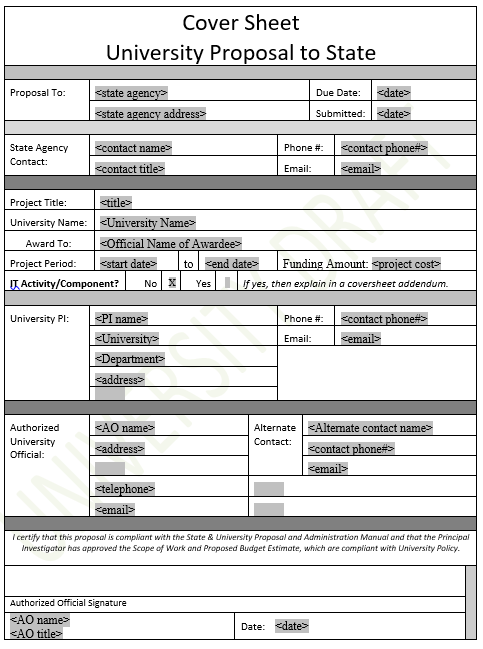Research Policy Analysis and Coordination
State/University Proposal Cover Sheet
University proposals may be accompanied by a completed Proposal Cover Sheet, signed by the University’s Authorized Official. Regardless of whether CMA forms or agency-specified forms are used for a proposal, the University authorized official approval (on the Proposal Cover Sheet or otherwise) is required. An optional Proposal Cover Sheet can be found at the end of this CMA Guide and looks like this:

Populating the ‘University Name’ and ‘Award To’ fields on the Proposal Cover Sheet
The University Name is the campus or CSU auxiliary name. The ‘Award To’ field should contain the legal name of the entity receiving the award.
| Example | University Name | Award To |
|---|---|---|
| For an award to UC Berkeley | UC Berkeley | The Regents of University of California on behalf of its Berkeley campus |
| For an award to a CSU auxiliary organization | CSU Sacramento | University Enterprises Incorporated |
| For an award to a CSU University | San Francisco State University | San Francisco State University |
Populating the ‘IT Activity/Component’ question on the Proposal Cover Sheet
California Technology Agency (CTA) – SCIT (Service Contract Information Technology) Certification
In accordance with State Contracting Manual (Volume 1) §1.05, Classification of Contracts, Section B5, a non-Information Technology (IT) services contract is one where the sole or primary purpose is providing non-IT services. The CMA template does not contain all necessary terms for a service agreement wherein the primary purpose is for a University campus to provide IT activities (as defined in the State Administrative Manual (SAM) section 4819.2 excerpted below) to a state agency. However, sometimes a non-IT services contract may include some IT activity so long as the IT activity is not the primary purpose of the project.
To assist the State agency in determining if the University is performing an IT activity in a non-IT services agreement, as defined below, check “No” or “Yes” on the Proposal Cover Sheet. If “Yes”, provide additional information on the IT Activity/Component Addendum, including a description of the ancillary IT activity or component and how it is necessary to complete the project, but not primary to the project’s purpose.
IT activities are defined in SAM section 4819.2 (PDF) as follows:
Information Technology Activities. Any activity listed below, or any combination of these activities for a single information technology project, is to be considered an “information technology activity.”
- IT facility preparation, operation and maintenance.
- Information management planning.
- Feasibility determination, development and implementation of application systems or programs, or changes to application systems or programs to meet new or modified needs, or maintenance, including: Project Approval Lifecycle State/Gate deliverable preparation, systems analysis, systems design, purchase and installation of software, programming, conversion of data or programs, documentation of systems and procedures, and project appraisal or assessment.
- Operation of application systems or programs including handling, assembling, or editing of input-output data or media where information technology equipment or information technology personnel are used.
- Information Technology Procurement.
- Installation, operation, and maintenance of data processing equipment, IT equipment, goods and services and software.
- Other installation management activities including performance measurement, system tuning, and capacity management.
- Preparation and administration of requests for proposals or bid solicitations for contracts for any of the above activities.
- Preparation of contracts, interagency agreements, and purchase estimates for any of the above activities.
- Employment of personnel in support of, or directly related to, any of the above activities, including: administration, technical services, clerical services, travel, training, and preparation of periodic and special reports.
- Control functions directly related to any of the above activities.
